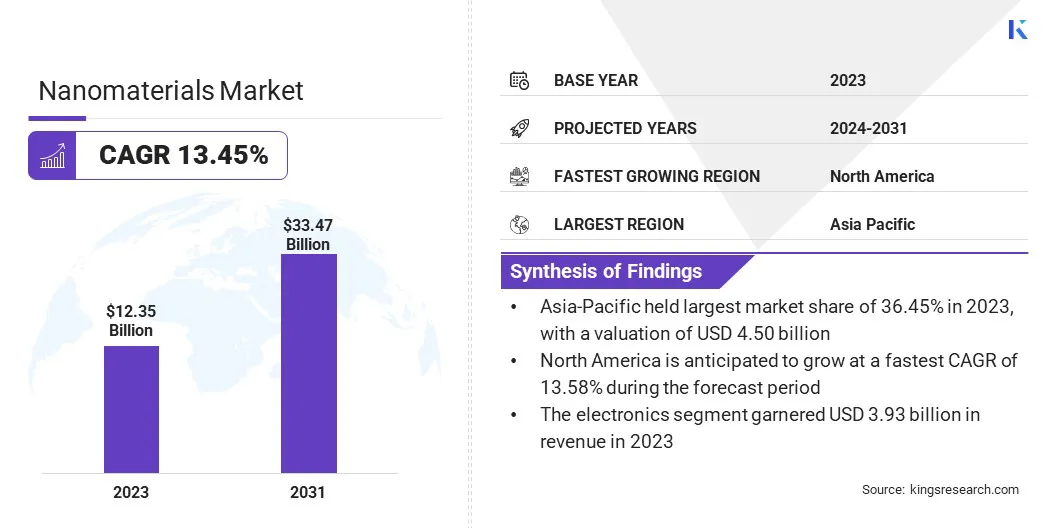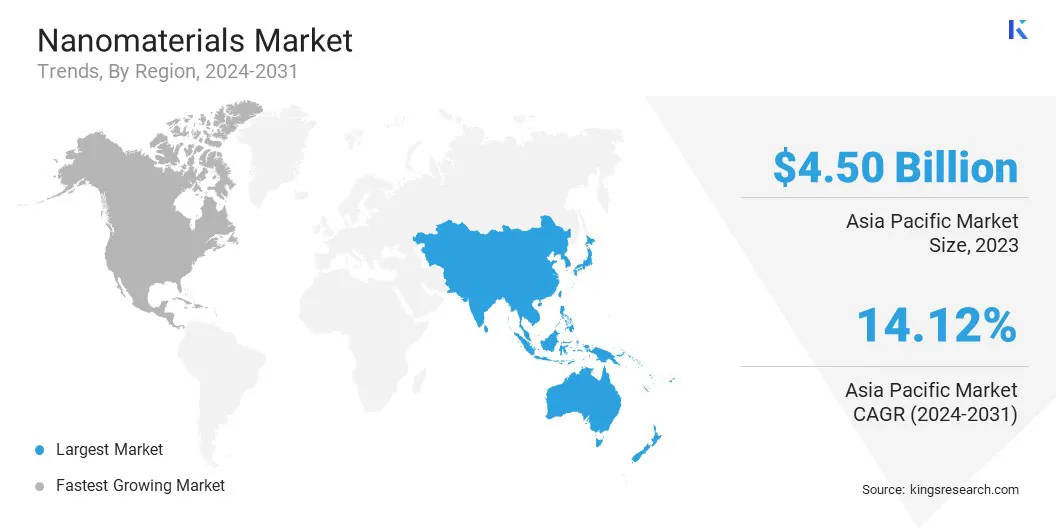Nanomaterials Market Size
The global Nanomaterials Market size was valued at USD 12.35 billion in 2023 and is projected to grow from USD 13.84 billion in 2024 to USD 33.47 billion by 2031, exhibiting a CAGR of 13.45% during the forecast period.
The global market is experiencing steady growth due to strong demand in consumer electronics for lightweight, high-performance, and durable materials. Additionally, advancements in nanotechnology and its manufacturing processes are extending the potential applications of nanomaterials in various industries, fueling market expansion.
In the scope of work, the report includes End-Use offered by companies such as American Elements, Nanophase Technologies Corporation, Quantum Materials Corporation, Arkema Group, nanoComposix, US Research Nanomaterials, Inc., Advanced Nano Products Corporation, SkySpring Nanomaterials, Inc., Evonik Industries AG, Graphene Nanochem Plc., and others.
Nanomaterials are extensively used in pharmaceuticals for the accurate detection of biological molecules, safe imaging of sick tissue, and innovative treatments owing to their unique optical, chemical, mechanical, and electrical properties.
Carbon-based nanomaterials have been used for the treatment of infections, allergies, pain, asthma, and cancer. Rising prevalence of water-borne disease, supported by limited access to clean water, is contributing to the growth of the nanomaterials market.
- In 2022, the World Health Organization reported that at least 1.7 billion people worldwide consume contaminated water globally, leading to increased cases of diarrhea, dysentery, and cholera disease.
Additionally, the use of nanomaterials in water treatment process, particularly through nanotechnology, is rising the demand for nanomaterials. Nanomaterials are widely used across several industries such as pharmaceutical, electronic, automotive, and food and drugs . These industries demand strict safety protocols and regulatory compliance to protect health and the environment.
Due to the possible risks of nanomaterials, many developed countries participate in international organizations, including the Organization for Economic Co-operation and Development the Working Party on Manufactured Nanomaterials (OECD WPMN), International Organization for Standardization / Technical Committee 229 (ISO/TC 229), Registration, Evaluation, Authorization, and Restriction of Chemicals Annex (REACH Annex).
- For instance, the Korean Government actively participates in the ISO and OECD to enhance nanomaterials safety.
These organizations have imposed nanomaterial test guidelines standardization work and trade regulations to ensure the safe distribution of nanomaterials across the globe.

Analyst’s Review
The nanomaterials market is witnessing significant growth in various fields such as healthcare, energy, and electronics. Manufacturers are adapting an sustainable production methods to enhance performance and efficiency in the industrial processes and consumer products.
Companies are doing R&D investments and governments are taking initiatives to promote nanomaterials driving market growth. For instance, Ministry of Electronics and Information Technology India taken various initiatives for the promotion of Nanoelectronics research and innovation in India.
Most countries are also focusing on safety by developing an standards and guidelines for the production, handling, and disposal of nanomaterials to lower health and environmental risks. Companies are also emphasizing on technological advancements for different applications in nanomaterials.
Nanomaterials Market Growth Factors
The increasing use of nanomaterials in the healthcare sector is aiding the growth of the nanomaterials market. These materials are utilized to analyze and isolate specific cells, generic material, proteins, enablingg quick and accurate disease diagnosis.
- For instance, in 2021, a report by the Press Trust of India (PTI), identified 400 major nanotech companies, the majority of which are focused on nanomedicine. Among these, 30 to 40 companies are based in India.
The demand for nanomaterials is anticipated to rise due to the aging population, an increasing prevalence of cardiovascular diseases, technological advancements, and the rising global incidence of chronic diseases.
The nanomaterials market faces challenges due to health risks associated with their use. Nanomaterials can penetrate biological barriers, including the skin, lungs, and blood-brain barrier, raising questions about their interaction with cells and tissues.
Inhalation of nanoparticles, for instance, can lead to respiratory issues such as inflammation, fibrosis, and chronic obstructive pulmonary disease. Furthermore, certain nanomaterials, such as carbon nanotubes, resemble asbestos fibers and may increase the risk of lung cancer with longer exposure.
Moreover, nanoparticles can produce reactive oxygen species (ROS), causing oxidative stress, DNA damage, and cell death, which are associated with a number of chronic diseases such as cancer and cardiovascular disease .
Nanomaterials Market Trends
The rising use of nanomaterials in drug delivery system is improving treatment efficacy by reducing side effects and targeting specific cells, which is emerging as a major trend reshaping the market landscape. Innovations in nanomedicine, such as nanoparticles delivering chemotherapy directly to tumor sites, are transforming cancer treatment.
- For instance, as per the article published by springer nature limited, 19.3 million people diagnosed with cancer, and about 10 million people died per year.
Nanomaterials such as quantum dots and superparamagnetic nanoparticles improve diagnostic imaging by allowing for high-resolution MRI, CT, and fluorescence imaging, aiding early disease detection and treatment monitoring. Nanofibers and nanoparticles in biomaterials promote tissue regeneration for wound healing and organ transplantation.
Additionally, nanomedicine advances in targeted cancer therapy, vaccine delivery, gene editing, and biosensing, fostering innovation in healthcare. The use of nanomaterials in the automotive sector is rapidly increasing due to their capacity to improve performance, durability, and efficiency. Nanomaterials such as carbon nanotubes, graphene, and nanocomposites are applied in automotive components to reduce weight, improve fuel efficiency, and increase safety.
- For instance, Ford's "Atoms to Engines" initiative has contributed to reducing the weight of aluminum engines, enhancing tire performance with carbon black for better grip and lower rolling resistance, and incorporating nanomaterials in Li-ion batteries to shorten recharge times.
Key applications include lightweight structural materials, corrosion and wear-resistant coatings, and energy-efficient batteries, which help manufacturers meet stringent environmental regulations while enhancing vehicle performance and sustainability.
The growing demand for sustainable and eco-friendly materials is increasing investment in nanomaterial research. As industries aim to reduce their enviornametal impact and comply with strict regulation, the need for high-performance, sustainable nanomaterials is rising.
Materials such as graphene, carbon nanotubes, and quantum dots are being extensively studied for their transformative potential across numerous industries. Consequently, efforts to develop environmentally benign nanomaterials are advancing rapidly, with emerging markets playing a crucial role in innovation and reshaping the landscape of the global nanomaterials sector through significant investments in R&D.
Segmentation Analysis
The global market has been segmented based on mode of type, end-use industry, and geography.
By Type
Based on type, the nanomaterials market has been categorized into carbon-based, metal based, dendrimers-based, and composite. The carbon-based segment garnered the highest revenue of USD 5.10 billion in 2023. Carbon based nanomaterials are widely utilized in lithium-ion batteries and super capacitor electrodes due to their exceptional thermal conductivity.
These materials are also used as a catalyst in electrode-assisted polymer electrolyte membrane (PEM) fuel cells. Titanium dioxide nanoparticles are anticipated to witness a significant increased demand for their ability to prevent bacterial growth and prevent new cell formation.
As demand for high reversible capacity, improved safety, and long-term stability in lithium-ion batteries grows, significant research has focused on manufacturing high-performance cathode materials. Carbon-based materials are considered promising candidates for evolving cathodes due to their high electrical conductivity, huge surface area, and structural stability.
By End-Use
Based on end-use, the market has been categorized into automotive, aerospace, healthcare, electronics, construction, and others. The electronics segment captured the largest revenue share of 31.84% in 2023. The growing demand for lighter, faster, and more efficient electronic devices underscores the increasing importance of integrating nanomaterials into electronics manufacturing.
- For instance, according to JEITA, the global electronics production is anticipated to increase in 2023, and reach USD 3,526.6 million.
Nanomaterials are critical role in advancing technology, fostering innovations from flexible displays to improved semiconductor devices, and influencing the electronics industry. They are widely used to manufacture a variety of electrical devices, circuits, optics, graphene electrodes, display technologies, and nanoelectronics, among others.
Nanomaterials Market Regional Analysis
Based on region, the global market has been classified into North America, Europe, Asia-Pacific, MEA, and Latin America.

Asia-Pacific nanomaterials market accounted for the largest revenue share of 36.45% in 2023, with a valuation of USD 4.50 billion. This dominance is largely attributed to strong industrial demand, technological advancements, and extensive research and development activities.
China, Japan, South Korea, and India dominate the market due to their robust manufacturing sectors and investments in nanotechnology. China, in particular, leads with its large-scale manufacturing capabilities, considerable government financing for nanotechnology research, and rapid industrialization incorporating nanomaterials into electronics, healthcare, energy, and consumer products.
Japan and South Korea boast strong research and development infrastructure, along with emerging applications in the electronics, automotive, and medical industries.
India has made significant progress, with rising firms and research institutions concentrating on low-cost nanotechnology solutions for healthcare, agricultural, and environmental applications. The growth of the regional market is further supported by favorable regulations that promote public-private partnerships and international collaboration.
North America nanomaterials market is anticipated to witness significant growth, registering a CAGR of 13.58% over the forecast period. The United States contributes significantly to this expansion, fueled by substantial government support for nanotechnology, multiple technology incubators, and public-private sector partnership.
The presence of large universities and research centers contributes to nanomaterial invention and commercialization. The region's focus on sustainability and environmentally friendly solutions has bolstered the use of nanomaterials in energy storage and renewable energy applications, enhancing battery performance and solar panel efficiency.
Furthermore, advancements in medical diagnostics and drug delivery methods are advancing the healthcare sector. North America nanomaterials industry has matured, consolidated, and adopted new technologies to improve product performance. This expansion is largely attributed to the region's status as a global manufacturing powerhouse.
The regional market is likely to grow further, propelled by continuous research and development in nanomaterials and nanotechnology, aimed at identifying potential applications across a wide range of industries
Competitive Landscape
The global nanomaterials market report will provide valuable insight with an emphasis on the fragmented nature of the industry. Prominent players are focusing on several key business strategies such as partnerships, mergers and acquisitions, product innovations, and joint ventures to expand their product portfolio and increase their market shares across different regions.
Companies are implementing impactful strategic initiatives, such as expanding End-Uses , investing in research and development (R&D), establishing new End-Use delivery centers, and optimizing their End-Use delivery processes, which are likely to create new opportunities for market growth.
List of Key Companies in Nanomaterials Market
- American Elements
- Nanophase Technologies Corporation
- Quantum Materials Corporation
- Arkema Group
- nanoComposix
- US Research Nanomaterials, Inc.
- Advanced Nano Products Corporation
- SkySpring Nanomaterials, Inc.
- Evonik Industries AG
- Graphene Nanochem Plc.
Key Industry Developments
- December 2023 (Launch): The California NanoSystems Institute at the University of California, Los Angeles (UCLA) introduced nanoparticles made of a medium-entropy alloy containing nickel, palladium, and platinum. This material is key in the development of medium- and high-entropy alloys, with applications in construction, transportation, appliances, tools, and electronics.
- November 2022 (Launch): American Elements launched a novel nanoscale electrolyte material for lithium-ion batteries. This energy-dense ceramic electrolyte is made up of lithium, lanthanum, and zirconium oxide nanoparticles.
The global nanomaterials market has been segmented as:
By Type
- Carbon-Based
- Metal Based
- Dendrimers-based
- Composite
By End-Use
- Automotive
- Aerospace
- Healthcare
- Electronics
- Construction
- Other
By Region
- North America
- Europe
- France
- UK
- Spain
- Germany
- Italy
- Russia
- Rest of Europe
- Asia-Pacific
- China
- Japan
- India
- South Korea
- Rest of Asia-Pacific
- Middle East & Africa
- GCC
- North Africa
- South Africa
- Rest of Middle East & Africa
- Latin America
- Brazil
- Argentina
- Rest of Latin America


